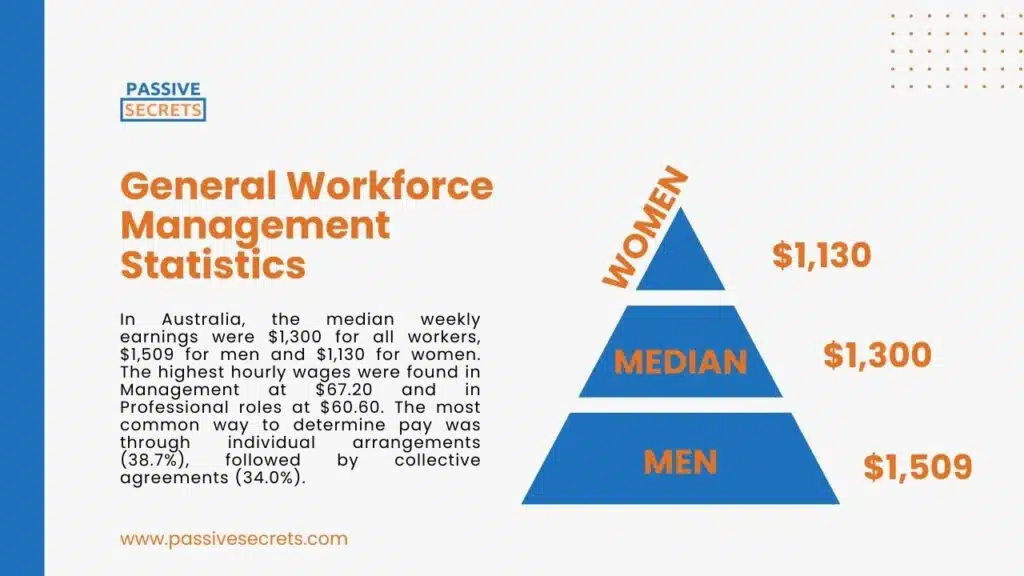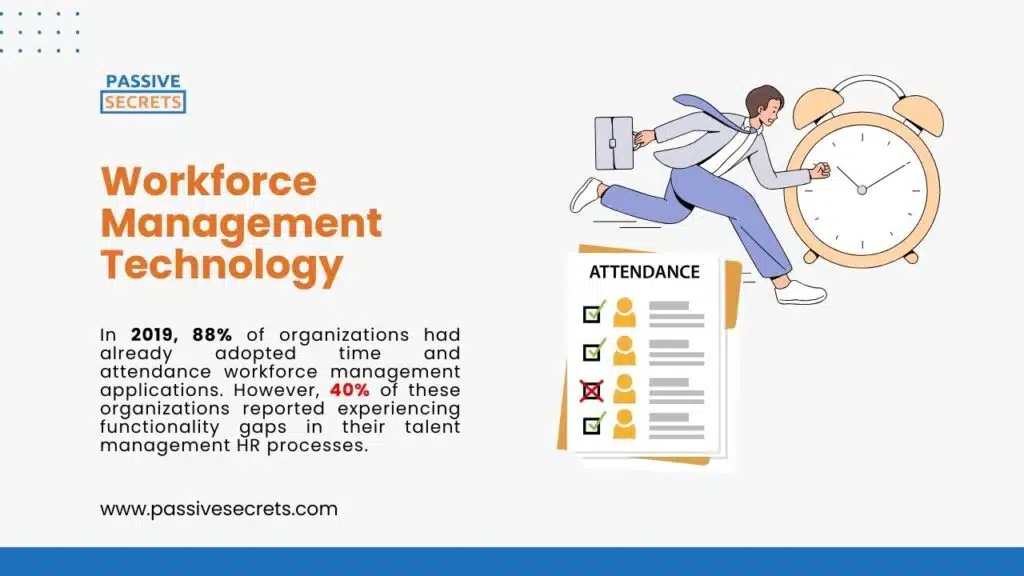
Imagine a big office with lots of people working together. Workforce management is like the glue that keeps everything stuck together. It makes sure everyone is doing their job at the right time.
Workforce management is similar to a big orchestra with lots of different instruments. The conductor is the workforce manager, and their role is to ensure all the instruments play together at the right time. If they don’t, the music won’t sound good.
Workforce management is super important for companies. It helps them work better and make more money. It’s the heart of every company, and if the heart doesn’t work, the whole body won’t work either.
Most companies lack the right workforce management strategy to integrate their workflows, which affects their outcomes.
By examining the latest workforce management statistics, organizations can gain a deeper understanding of the trends, challenges, and opportunities that lie ahead.
In this article, we’ll examine the most up-to-date workforce management statistics, providing valuable insights to help you optimize your workforce management practices and drive your organization forward in today’s competitive landscape.
Key Workforce Management Statistics
- Europe is expected to contribute 33% to the global market growth during the forecast period (2024-2028).
- North America is projected to maintain the largest market size in the global workforce management market, while the Asia Pacific region is expected to grow at the highest CAGR.
- Market growth is challenged by a lack of skilled workforce due to the complex integration of ML and AI, data analysis, statistical modelling, and business strategy expertise required.
- North America is projected to dominate the global hospital workforce management market during the forecast period, holding a 36.8% market share in 2022.
- The workforce management software market was worth $8.8 billion in 2023 and is projected to expand at a CAGR of over 8.5% from 2024 to 2032.
- The focus on workforce optimization is anticipated to drive the workforce software market through 2032.
General Workforce Management Statistics

1. Europe is expected to contribute 33% to the global market growth during the forecast period (2024-2028). (source)
2. Approximately 34% of organizations in Europe currently utilize the Internet of Things for their business processes, with another 12% planning to implement it soon. (source)
3. In the Asia Pacific, the management-to-employee ratio at professional services organizations was 12.11 in 2018. (source)
4. In Australia, the median weekly earnings were $1,300 for all workers, $1,509 for men and $1,130 for women. The highest hourly wages were found in Management at $67.20 and in Professional roles at $60.60. The most common way to determine pay was through individual arrangements (38.7%), followed by collective agreements (34.0%). (source)
Workforce Size and Composition
5. North America is projected to maintain the largest market size in the global workforce management market, while the Asia Pacific region is expected to grow at the highest CAGR. (source)
6. Key companies in the global workforce management market include Oracle (US), Kronos (US), ADP (US), SAP (Germany), Ultimate Software (US), and Workforce Software (US). (source)
7. North America is a key region contributing to market growth, and data analytics solutions are used to assess workforce performance, manage staffing, and enhance employee collaboration and engagement. (source)
8. 84% of participants indicated they plan to hire new permanent employees with skills related to emerging technologies. (source)

Productivity and Performance
9. Market growth is challenged by a lack of skilled workforce due to the complex integration of ML and AI, data analysis, statistical modelling, and business strategy expertise required. (source)
10. A European survey in October 2022 revealed that six out of ten companies use HR and people analytics to gain insights into staff shortages and absenteeism. Additionally, 21% of respondents expressed a desire to start using these tools within the next year, representing a 15% increase from the previous year. (source)
Hospital Workforce Management
11. The global hospital workforce management market is predicted to grow at a CAGR of 10.6% during the forecast period, reaching approximately US$ 4,209.5 million by 2033. Between 2018 and 2022, the market saw substantial growth with a CAGR of 7.1%. (source)
12. In 2023, the global hospital workforce management market is forecasted to be valued at US$ 1,533.2 million. (source)
13. In 2022, Europe held 29.4% of the hospital workforce management market. It is expected to be the second-largest market due to the region’s ageing population, which will likely drive the use of healthcare workforce management systems for effective healthcare solutions. (source)
14. North America is expected to lead the global healthcare workforce management systems market, driven by increasing awareness of efficient labour management solutions in the healthcare sector. (source)
15. North America is projected to dominate the global hospital workforce management market during the forecast period, holding a 36.8% market share in 2022. (source)

Workforce Management Technology
16. The global workforce management market is expected to grow from $6.0 billion in 2020 to $9.3 billion by 2025, with a CAGR of 9.3%. The increasing need for workforce optimization and mobile applications is a major growth driver. (source)
17. The workforce management software market was worth $8.8 billion in 2023 and is projected to expand at a CAGR of over 8.5% from 2024 to 2032. (source)
18. The focus on workforce optimization is anticipated to drive the workforce software market through 2032. (source)
19. The COVID-19 pandemic significantly impacted the workforce management software market by accelerating remote work adoption and increasing demand for tools to manage distributed teams effectively. (source)
20. The time and attendance management segment accounted for 25% of the workforce management software market share in 2023, driven by the need for greater efficiency. (source)
21. In 2023, the cloud segment held approximately 35% of the workforce management software market share. (source)
22. In 2019, 56% of organizations stated that workforce management technology generally met their business needs. Additionally, 43% of large organizations reported having a culture of Change Management. (source)
23. The workforce analytics market is projected to grow by USD 2.56 billion at a CAGR of 17.74% between 2023 and 2028. (source)
24. North America accounted for 30% of the workforce management software market revenue in 2023 due to its advanced technological infrastructure and early adoption of digital solutions. (source)
25. The top three companies in the workforce management software industry are Oracle Corporation, SAP SE, and ADP, Inc. (source)
26. The Europe Workforce Management Software Market is projected to grow from USD 2.45 billion in 2024 to USD 3.71 billion by 2029, with a compound annual growth rate (CAGR) of 8.67%. (source)
27. The Asia-Pacific Workforce Management Software Market is projected to grow from USD 1.77 billion in 2024 to USD 2.78 billion by 2029, with a compound annual growth rate (CAGR) of 9.42% during this period. (source)
28. In 2020, the time and attendance segment was the largest in the workforce management applications market, generating about $2.4 billion in revenue. This segment grew by nearly $700 million between 2018 and 2020. (source)
29. In 2019, 88% of organizations had already adopted time and attendance workforce management applications. However, 40% of these organizations reported experiencing functionality gaps in their talent management HR processes. (source)

Latest Workforce Management Trends
1. AI and Automation Capabilities
AI and automation capabilities have become a top workforce management trend. It allows organizations to improve their accuracy levels, creating a more agile and responsive work environment.
It also helps to automate tasks that involve repetition. This helps to curtail problems such as overstaffing or understaffing.
Technological advances have made life much easier for many organizations, especially when automated scheduling and task allocation based on employee preferences and skills are enabled.
AI and automation are expected to streamline workforce management processes further. AI will continue refining its predictive capabilities, while automation will reduce the need for human intervention in some routine tasks.
By embracing these technologies, organizations can enhance operational efficiency and improve customer and employee experiences.
2. Upskilling
Upskilling involves enhancing employees’ skills, which are crucial for their career growth within a company.
This process enables employees to acquire new skills and adjust to the evolving demands of their jobs as industries and technologies change.
Workforce management tools can identify skill deficiencies and offer data-driven insights to support upskilling efforts.
By focusing on upskilling, organizations can boost employee retention, foster adaptability to changes, and stay competitive by having the right talent.
Thus, upskilling has become an essential strategy for preparing workforce management for the future and ensuring employees possess the skills to meet changing business demands.
3. CyberSecurity and Compliance
Cybersecurity remains a top concern, with 61% of companies more worried about how they could actively enhance security measures.
Organizations are investing in upskilling and reskilling their existing workforce to address this. This helps leverage the current workforce’s experience and knowledge to meet evolving cybersecurity and compliance requirements.
Integrating AI and automation into workforce management also enhances cybersecurity capabilities. AI-powered algorithms can analyze data, identify patterns, and automate security tasks, freeing up employees to address more pressing issues.
This helps organizations stay ahead of cyber threats and maintain compliance.
Effective cybersecurity and compliance are now essential for workforce management in 2024 and beyond as businesses navigate an increasingly complex digital landscape
4. Remote and Hybrid Working
In 2024, remote work emerged as a major trend in workforce management. The COVID-19 pandemic enabled the shift towards remote and hybrid work models.
Employees increasingly seek the flexibility and improved work-life balance that remote work provides, prompting companies to adapt accordingly.
Nevertheless, remote work brings challenges for employers, such as security concerns.
This has led some companies to implement monitoring software to oversee remote employees. Companies are also creating policies and deploying collaboration tools to manage remote workforces effectively.
Companies navigating this transition will be better positioned for future success.
Conclusion
The workforce management statistics presented in this article offer valuable insights into the shifting landscape of modern work.
As the global market grows, organizations recognize the importance of investing in workforce management technology, analytics, and strategies to optimize productivity, engagement, and retention.
With the rise of remote and hybrid work, the need for effective workforce management has never been more pressing.
By understanding these workforce management statistics, businesses can make informed decisions to future-proof their workforce management practices, drive growth, and stay competitive in an increasingly dynamic market.
Stay ahead of the curve and leverage these workforce management statistics to transform your organization’s approach to managing its most valuable resource – its people.
FAQs
What is involved in a workforce management system?
Workforce management controls time management, absence management, employee management, payroll and benefits management, and all aspects of scheduling.
Why is a workforce management solution needed?
A workforce management solution saves time, effort, and money. It ensures the right amount of labour is utilized to achieve adequate results and eliminates unnecessary costs and risks.
What type of workforce management solutions are available?
There are time and attendance software, absence planning software, scheduling, and workforce planning software.
How does workforce management help with teamwork?
A workforce management system enables managers to coordinate with their teams efficiently. It eliminates the need for physical record-keeping and reduces the frequency of manager calls, often leading to conflicts among teams and employees.
How does workforce management help with record keeping?
Workforce management systems enable team members to regularly update information related to daily schedules, shift timings, attendance, absenteeism, late arrivals, and various other aspects. Additionally, these systems allow for the maintenance of data regarding different projects, client profiles, employees assigned to each project, tasks completed, and feedback received.

Other Similar Statistics That Will Interest You:
- 80+ Employee Benefit Statistics: Insights and Trends
- The Most Important Wealth Management Statistics You Can’t Afford to Ignore
- Enterprise Data Management: Essential Statistics and Emerging Trends
- 93 Talent Management Statistics to Help You
- Top Reputation Management Statistics and Trends to Improve Your Brand
- 36 Helpful Social Worker Burnout Statistics To Know
- 100 Business Process Outsourcing Statistics & Facts
- Top HR Outsourcing Statistics and Trends Every Business Must Know
- The Top Outsourcing Statistics You Shouldn’t Ignore
- 47+ Shocking 4-day Work Week Statistics To Know
- 105+ Supply Chain Statistics & Facts You Can’t Ignore
- 50+ Interesting Employer Branding Statistics And Trends
- Job Seekers Statistics: Unemployment Rates, Preferences, Challenges
- 95 Interesting Job Interview Statistics and Huge Trends To Know
- 60+ Helpful Change Management Statistics & Facts
- 65+ Employee Performance Management Statistics & Trends
- 73 Revealing Workplace Distraction Statistics
- Workplace Romance Statistics: How Common Is Workplace Romance?
- 40+ Top Workplace Conflict Statistics You Should Know
- The State of Workplace Communication: Key Statistics and Trends
- 55 Workplace Collaboration & Teamwork Statistics

